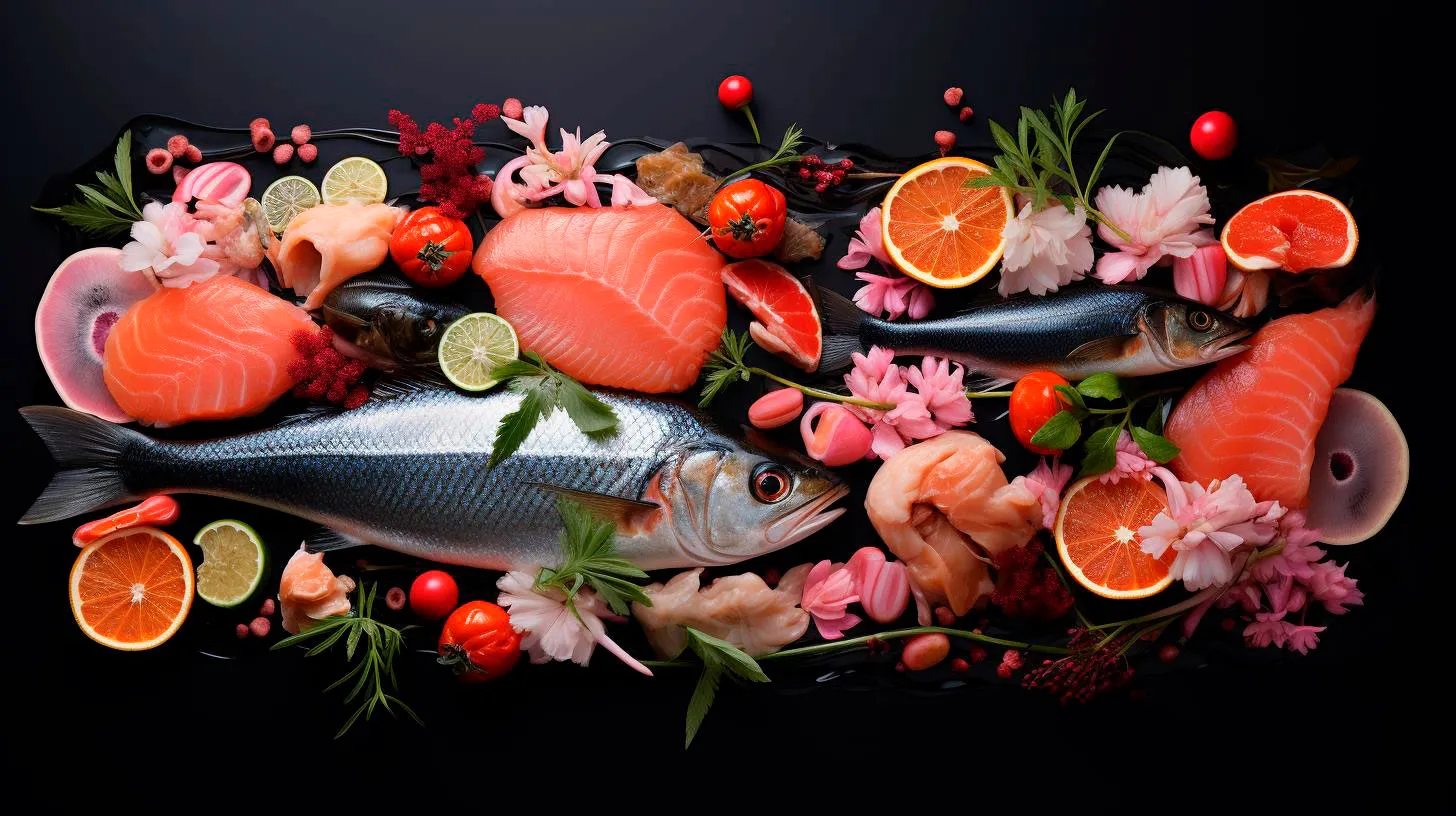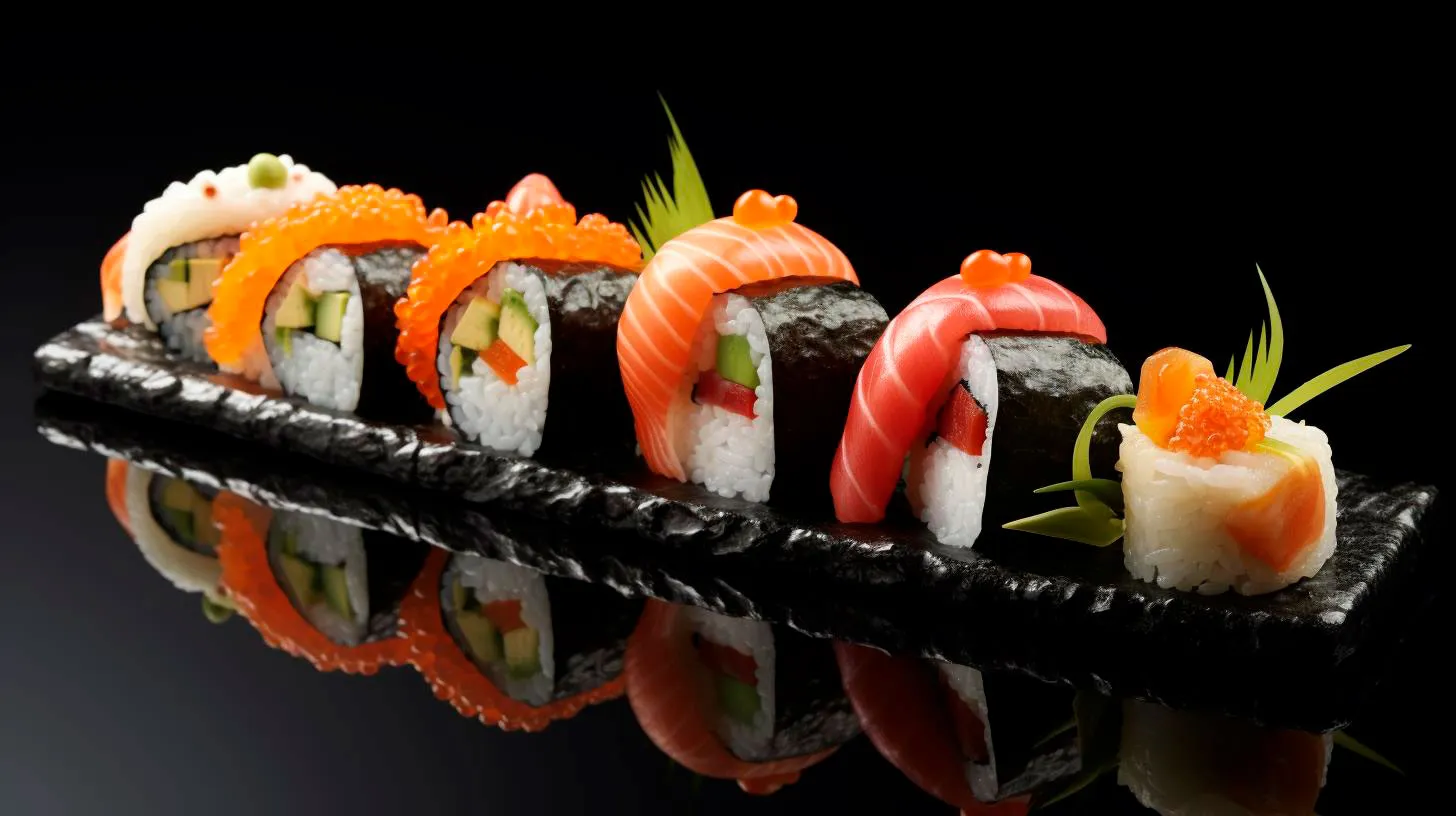Lunchtime Bliss: A Sushi Adventure
From the tantalizing flavors to the beautiful presentation, sushi is a culinary delight that enchants the senses.
Sushi, originating from Japan, has taken the world by storm with its unique combination of rice, fresh seafood, and other delicious ingredients. Here, we delve into the world of sushi, exploring its diverse offerings, health benefits, and how you can make the most of your lunchtime sushi experience.
The Sushi Menu: A World of Choices at Your Fingertips
As you sit down at a sushi restaurant or browse through an online menu, the variety of sushi options can be overwhelming. To help you navigate this delightful adventure, here are some key sushi varieties you can expect:
- Nigiri: These bite-sized pillows of vinegared sushi rice topped with a thin slice of fresh fish or seafood are a sushi classic. Each piece is carefully handcrafted to balance the flavors and textures.
- Maki Rolls: Maki rolls consist of sushi rice and various ingredients wrapped in nori seaweed. From the popular California roll to the tempura-filled dynamite roll, maki rolls offer a burst of flavors in every bite.
- Sashimi: If you are a seafood lover, sashimi should be on your must-try list. Sashimi is thinly sliced, raw fish or seafood served without rice, allowing you to savor the purity and freshness of the ingredients.
- Temaki: Often referred to as hand rolls, temaki is a cone-shaped sushi roll that is perfect for on-the-go consumption. With a crisp nori wrapping and an assortment of fillings, temaki is a convenient and delicious option.
These are just a few examples of the myriad sushi options available at most restaurants. Each bite promises a distinct combination of flavors, textures, and visual artistry that sets sushi apart.
The Benefits of Sushi: Nutritious and Delicious
Not only is sushi a treat for your taste buds, but it also offers several health benefits. Here are a few reasons why sushi has gained popularity as a nutritious choice:
- High in Omega-3 Fatty Acids: Fish such as salmon, tuna, and mackerel are packed with omega-3 fatty acids, which promote heart health, reduce inflammation, and support brain function.
- Low in Calories and Fat: Compared to many other cuisines, sushi is relatively low in calories, making it an excellent choice for those watching their weight. Opt for sashimi or rolls with lean protein for a guilt-free meal.
- Rich in Antioxidants: Ingredients like seaweed, ginger, and wasabi not only enhance the flavors but also offer essential antioxidants that contribute to overall well-being.
- Good Source of Protein and Micronutrients: Sushi is a great way to incorporate protein into your diet. With additional benefits from ingredients like avocado, cucumber, and pickled vegetables, sushi becomes a wholesome meal packed with vitamins and minerals.
Remember to enjoy your sushi in moderation, as some rolls may contain higher levels of sodium or sugar due to certain sauces or fillings.
Making the Most of Your Sushi Adventure
To enhance your sushi adventure, here are some tips to keep in mind:
- Try a Variety: Don’t be afraid to venture beyond the familiar. Experiment with different types of rolls, sashimi, and nigiri to discover new flavors and textures.
- Ask for Recommendations: If you’re unsure about what to try, don’t hesitate to ask the chef or the staff for their recommendations. They can guide you based on your preferences and dietary restrictions.
- Enjoy the Accompaniments: Sushi is often served with soy sauce, wasabi, and pickled ginger. Each of these condiments adds its own unique flavor profile. Dip your sushi lightly in soy sauce, dab a bit of wasabi for an extra kick, and cleanse your palate with pickled ginger.
- Appreciate the Artistry: Take a moment to appreciate the beauty of each sushi piece before consuming it. Notice the precision in cutting the fish, the carefully crafted rolls, and the delicate presentation.
- Embrace Chopsticks: While eating sushi with chopsticks may seem challenging at first, it adds to the authenticity and finesse of the experience. Embrace the traditional way of dining and enjoy the satisfaction of mastering this skill.
Embark on your lunchtime sushi adventure with an open mind, a craving for exploration, and an appreciation for Japanese culinary artistry. Immerse yourself in the flavors, textures, and the ambiance of the sushi bar, and let the experience transport you to a state of lunchtime bliss!
Savor the Bliss: Exploring the World of Sushi
So, fasten your seatbelts and get ready for a delectable journey!
The Captivating History of Sushi
Sushi has a history that spans over a thousand years. Originally conceived as a method of preserving fish by fermenting it with rice, sushi has evolved into an art form that tantalizes taste buds. Here are some key historical facts:
- The first appearance of sushi dates back to the second century A.D. in China.
- In the 8th century, sushi made its way to Japan, where it started to develop distinct flavors and techniques.
- Sushi was initially consumed by street vendors but gradually gained popularity among the upper class in the Edo period (1603-1867).
- In the 19th century, sushi underwent a major transformation with the introduction of vinegared rice, which is the defining element of modern sushi.
These historical milestones of sushi provide us with a glimpse into the journey of this delectable delicacy throughout the ages.
Types of Sushi: From Classic to Contemporary
Sushi can be divided into several types, each bringing its own unique flavor profiles and textures to the table. Let’s explore a few of the most popular ones:
1. Nigiri:
Nigiri is the quintessential sushi that comes to mind when we think of this Japanese delight. It consists of a small mound of vinegared rice topped with various ingredients, such as raw fish, seafood, or even tofu. Key features of Nigiri include:
- Ability to savor the natural flavors of the chosen ingredient.
- Visual appeal, with vibrant colors and fresh toppings.
- Expertly crafted by skilled sushi chefs who take pride in their artistry.
2. Maki:
Maki is a rolled sushi that consists of fillings wrapped inside sheets of seaweed (nori) and rice. It is usually served in bite-sized pieces and is perfect for those seeking a balance of textures and flavors. Notable features of Maki include:
- Endless combinations of fillings, such as raw fish, cooked seafood, vegetables, or even tempura.
- A visually pleasing dish with colorful ingredients peeking through the nori.
- Great for sushi enthusiasts who appreciate a good crunch.
3. Sashimi:
Sashimi is not technically sushi, but it plays an integral role in Japanese cuisine. It is thinly sliced raw fish or seafood served without rice. Sashimi offers a delightful experience for those who want to focus solely on the flavors of the seafood. Key takeaways for sashimi include:
- An emphasis on the freshness and quality of the seafood.
- A simple yet elegant dish that allows the ingredients to shine.
- Packed with omega-3 fatty acids and other nutrients, making it a healthy choice.
The Cultural Significance of Sushi
Sushi holds a special place in Japanese culture and extends far beyond being just a meal. Here are a few insights into its cultural significance:
- Sushi represents harmony in Japanese cuisine as it beautifully balances flavors, textures, and colors.
- It showcases Japan’s appreciation for the beauty of nature through the use of fresh and seasonal ingredients.
- The art of sushi-making is an intricate process that requires years of training, reflecting the Japanese dedication to mastery and perfection.
- Sushi restaurants provide a space for socializing, building connections, and enjoying intimate dining experiences.
Now that you have a better understanding of sushi’s history, types, and cultural significance, it’s time to grab those chopsticks and satisfy your cravings for this delectable delight!
Key Takeaways:
- Sushi has a fascinating history that dates back to ancient times.
- Nigiri, Maki, and Sashimi are just a few examples of the diverse types of sushi available.
- Sushi is not just a meal; it is a reflection of Japanese culture and values.
- Whether you’re a sushi aficionado or a curious newbie, exploring the world of sushi can be a truly blissful experience.
So, why not embark on your personal sushi adventure and indulge in the rich flavors and artistry that sushi has to offer? Savor the bliss of this culinary delight and let it transport you to the enchanting world of Japan.
Experience the Freshness of Sushi Delights
In this article, we will explore the exquisite world of sushi, its health benefits, and the numerous varieties you can choose from. So, sit back, relax, and let’s dive into the fascinating world of sushi!
The Art of Sushi
Sushi is much more than just raw fish and rice. It is a form of culinary art that originated in Japan and has evolved over the centuries. The word “sushi” refers to vinegared rice, which is combined with a variety of ingredients, including fresh fish, vegetables, and even fruits. The preparation of sushi involves precision, skill, and attention to detail. Each sushi roll is carefully crafted to ensure the perfect balance of flavors and textures. Whether you prefer traditional nigiri sushi, rolled sushi (maki), or hand-formed sushi (temaki), there is something for everyone’s taste.
Health Benefits of Sushi
Apart from its delectable taste, sushi also offers numerous health benefits. Here are some key advantages of including sushi in your diet:
- Rich in Omega-3 Fatty Acids: Sushi often contains fatty fish like salmon and tuna, which are packed with heart-healthy Omega-3 fatty acids. These fatty acids help reduce the risk of heart disease and promote brain health.
- Low in Calories: Sushi is relatively low in calories compared to many other cuisines. By opting for sushi rolls that incorporate lean proteins and vegetables, you can enjoy a delicious meal without worrying about excessive calorie intake.
- High in Essential Nutrients: Sushi is a great source of essential nutrients such as protein, vitamins, and minerals. Ingredients like seaweed (nori) provide an abundance of vitamins A, C, and E, as well as iodine and iron.
- Improves Digestion: Fermented sushi toppings like pickled ginger (gari) and fermented soy sauce (shoyu) contain probiotics that aid digestion and promote a healthy gut.
The Variety of Sushi
One of the most exciting aspects of sushi is the vast array of options to choose from. Here are some popular types of sushi you can enjoy:
- Nigiri Sushi: Consisting of a slice of fresh fish or seafood draped over a mound of sushi rice, nigiri sushi showcases the simplicity and quality of the ingredients.
- Maki Sushi: Maki sushi refers to rolled sushi, where a filling of fish, vegetables, and other ingredients is wrapped in a sheet of nori and rice. The rolls are then sliced into bite-sized pieces.
- Sashimi: Sashimi is not technically sushi as it doesn’t involve rice, but it is a must-try for seafood lovers. It consists of thinly sliced raw fish or seafood served without rice.
- Tempura Sushi: Tempura sushi adds a unique twist to traditional sushi by incorporating tempura-fried seafood or vegetables as a filling. The crispy texture complements the softness of the rice.
Key Takeaways
Sushi is a culinary delight that offers a fresh and healthy dining experience. Here are the key takeaways to remember:
- Sushi is an art form that combines vinegared rice with an array of ingredients.
- It offers numerous health benefits, including Omega-3 fatty acids and essential nutrients.
- The variety of sushi options, such as nigiri, maki, sashimi, and tempura sushi, ensures there’s something for everyone.
- So, indulge your taste buds and experience the freshness of sushi delights today!
In conclusion, sushi is not just a meal; it’s an experience. Its intricate flavors, artistic presentation, and health benefits make it a truly special dining choice. Whether you are looking to try sushi for the first time or are a seasoned connoisseur, exploring the diverse world of sushi will undoubtedly leave you craving for more. And with its rising popularity across the globe, it’s easier than ever to find a sushi restaurant near you. So, what are you waiting for? Treat yourself to the freshness of sushi delights and embark on a culinary adventure like no other!
Indulge in Sushi: A Treat for All
The Origins of Sushi
Sushi dates back to 4th century BC in Southeast Asia, where it was initially used as a preservation method for fish. Rather than cooking the fish, it was fermented with rice and salt, resulting in a tangy and flavorsome meal. Over the years, sushi evolved and found its way to Japan, where it transformed into the beloved dish we know today.
Sushi has now become synonymous with Japanese cuisine, and its popularity continues to soar globally. This culinary art form has evolved, allowing chefs to experiment with various ingredients and flavors, resulting in a diverse range of sushi options.
Types of Sushi
Sushi comes in various forms, each with its own unique presentation and taste. Here are some popular types of sushi:
- Nigiri: This classic sushi style consists of a slice of raw fish or seafood placed atop a small mound of rice. It is often garnished with a dab of wasabi.
- Maki: Maki rolls are made by wrapping rice, fish, and vegetables in a sheet of nori (seaweed). They are then sliced into bite-sized pieces.
- Sashimi: Sashimi is thinly sliced raw fish or seafood served without rice. It is usually enjoyed with soy sauce and wasabi.
- Temaki: These hand rolls are made by wrapping rice, fish, and vegetables in a cone-shaped piece of nori.
The Benefits of Sushi
Indulging in sushi not only treats your taste buds, but it also offers several health benefits. Here are some advantages of incorporating sushi into your diet:
- Rich in Omega-3 Fatty Acids: Most sushi contains fatty fish like salmon and tuna, which are excellent sources of omega-3 fatty acids. These healthy fats promote heart health and help reduce the risk of chronic diseases.
- Low in Calories: Sushi is a great option for those watching their calorie intake. With its focus on raw fish and vegetables, sushi can be a light and nutritious meal.
- High in Protein and Nutrients: Sushi provides a good source of lean proteins, vitamins, and minerals. The combination of fish, rice, and seaweed offers a balanced nutrition profile.
- Improves Digestion: Wasabi and ginger, common accompaniments to sushi, aid digestion and can prevent stomach discomfort.
Key Takeaways
Sushi is a culinary masterpiece that combines artistry and taste to create a memorable dining experience. Here are the key takeaways about sushi:
- Sushi originated in Southeast Asia and developed into a popular Japanese cuisine.
- There are various types of sushi, including nigiri, maki, sashimi, and temaki.
- Sushi offers numerous health benefits, including omega-3 fatty acids, low calories, and essential nutrients.
- Enjoying sushi is an excellent way to explore new flavors and indulge in a unique culinary experience.
So, the next time you’re looking for a sophisticated and tasty treat, consider indulging in sushi. With its rich history, varied types, and health benefits, sushi is truly a treat for all.



